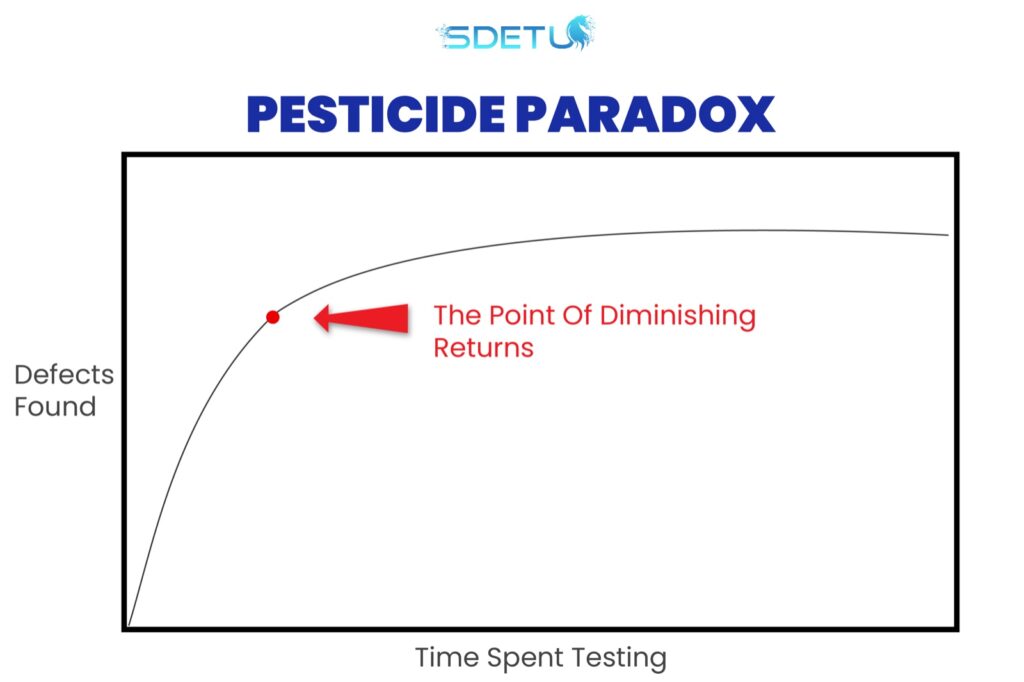Software testing plays a crucial role in the software development life cycle as it helps ensure the quality, reliability, and performance of the final product. Software testing is not just about finding defects; it also provides valuable insights into the overall quality of the software. By conducting effective software testing, it shows how well the application behaves in different scenarios and whether it meets user expectations.
By following best practices and principles of software testing, developers can build more robust and reliable software solutions that ensure user satisfaction.
In this blog, “7 Principles of Software Testing with Examples,” we will explore the principles of testing that guide effective software testing practices.
Introduction to the 7 principles of software testing
Let’s explore the seven fundamental principles of software testing. These principles serve as guidelines for effective testing strategies and robust software solutions. Here are the principles of software testing:
Testing Shows the Presence of Defects
Exhaustive Testing is Impossible
Early Testing Saves Time and Money
Defect Clustering
Pesticide Paradox
Testing is Context Dependent
Absence of Errors Fallacy
Principle 1: Testing Shows the Presence of Defects
The principle “Testing Shows the Presence of Defects” highlights that the main goal of testing is to uncover defects or issues within the software. It emphasizes that no software is entirely free of defects, and testing is crucial for identifying and fixing these hidden errors.
Example:
When a software testing team manually tests a new e-commerce website before its official launch, they navigate through various pages, add items to their cart, and proceed to checkout. During this process, they might find defects such as broken links or incorrect pricing calculations. Identifying these issues early helps ensure a more reliable and user-friendly product.
Principle 2: Exhaustive Testing is Impossible
The principle is a fundamental concept in software testing. It recognizes that resources such as time, budget, and human effort are limited, and it would be impractical to attempt all the test cases and every conceivable scenario. Instead, testers focus on identifying critical areas of the software that are most likely to contain defects or errors.
By adopting an effective test strategy, testing teams can maximize their efficiency and effectiveness in identifying defects. Also, by focusing on critical areas and leveraging automation tools, testers can enhance the quality of software products while optimizing their utilization of resources.
Example:
One practical example of strategic test case selection is Equivalence Partitioning. This technique involves dividing input data into equal classes that are likely to show the same behavior when processed by the software. Test cases are then designed to represent each equivalence class, ensuring that a representative set of inputs is tested without the need for exhaustive testing.
Principle 3: Early Testing Saves Time and Money

This principle emphasizes that testing activities should be initiated as early as possible in the software development life cycle (SDLC). The idea behind this approach is that it significantly helps in saving both time and money, a crucial aspect of an effective testing strategy.
A key component of this early engagement in testing is the development of test cases. These test cases are designed based on the initial requirements and design documents, even before the code is fully developed.
Example:
Imagine a team of developers working on a new online learning platform designed to help students can access educational materials easily. Before coding, the team decides to conduct early testing on the platform’s design and functionality. During testing they discovered that some buttons are too small for mobile users to tap accurately, and certain features don’t work smoothly on certain web browsers.
By highlighting these issues at early stage, the team can make adjustments to the design and code before they spend too much time and effort. This not only saves them from costly retesting later but also ensures that students will have a seamless learning experience right from the beginning.
Principle 4: Defect Clustering

Defect Clustering in software testing is best explained through the Pareto principle. According to the Pareto principle, also known as the 80/20 rule, approximately 80% of the defects are found in 20% of the software modules.
This principle suggests that focusing on fixing the most critical 20% of the defects can lead to a significant improvement in the overall quality of the software. By identifying and addressing these key issues first, software testers can efficiently allocate their resources and prioritize their efforts to maximize the system’s reliability.
Understanding defect clustering and applying the Pareto principle can streamline the testing process and help in achieving higher user satisfaction.
Example:
In a customer relationship management (CRM) software, the module responsible for managing customer data, including contact information, communication logs, and sales history, is frequently accessed and heavily utilized by sales representatives and customer support agents. Due to its central role and complexity, this module often exhibits defect clustering which requires rigorous testing.
To address defect clustering, the software testers focus on thorough testing, code reviews, and proactive monitoring of this module, ensuring that it remains robust and reliable for users.
Principle 5: Pesticide Paradox

The pesticide paradox explains the rule of diminishing returns of running the same tests in software testing. Diminishing returns of running the same test means that testers must constantly analyze the effectiveness of the testing process. It involves the evaluation of test results to determine if further testing is providing valuable results or if allocating resources somewhere else will be better.
When the benefits of performing additional tests are outweighed by the costs, software testers should optimize their testing efforts and focus on areas of software that require more attention. Ultimately, understanding the concept of diminishing returns in testing is crucial for achieving optimal testing outcomes.
Example:
An appropriate real-world example of the Pesticide Paradox is an e-commerce platform undergoing continuous updates. As the e-commerce website evolves with new features, such as payment gateways, product recommendation algorithms, and user interfaces, the existing test suite may become ineffective.
Instead of running the same set of tests again and again, they may fail to find new defects in the updated features. To deal with the Pesticide Paradox, the testing strategy should be changed by incorporating new test cases, different testing techniques, and continuous assessment of the relevance and effectiveness of tests to maintain thorough test coverage and detect new errors in the software.
Principle 6: Testing is Context Dependent
Testing is content dependent is another principle of software testing which explains why testing approaches differ. The main reason behind this is that different types of software require unique testing strategies.
Understanding the specific requirements of software is important in determining the most effective testing strategy. By customized testing approaches according to the nature of the software, testers can ensure comprehensive coverage and identify potential issues more efficiently.
Example:
To illustrate this principle, let’s compare two different application types: a banking application and a gaming application.
For a banking application, the primary focus of testing would be on security, accuracy, and regulatory compliance. Test cases would need to cover functionalities such as account management, transaction processing, fund transfers, and data encryption to ensure the integrity and confidentiality of financial information.
Whereas, testing for a gaming application would emphasize factors such as user experience, performance, and functionality. Test cases would need to evaluate features like gameplay mechanics, graphics rendering, audio effects, and multiplayer interactions to ensure an enjoyable gaming experience.
These examples highlight how the context of the application significantly influences the testing approach.
Principle 7: Absence of Errors Fallacy
The absence of errors fallacy is another principle of software testing that explains why the absence of known defects doesn’t mean the software is ready. According to this principle, software testing can never guarantee the absence of all defects, as it is impossible to test all scenarios exhaustively.
This fallacy highlights the importance of thorough and diverse testing approaches to increase the likelihood of detecting potential problems. By understanding the limitations of software testing, testing teams can adopt strategies like risk-based testing and exploratory testing to uncover hidden defects.
Example:
To illustrate this concept, consider a mobile banking application that has undergone extensive testing and is deployed for public use. Despite rigorous testing procedures, no critical errors or crashes have been reported by users in the initial weeks after launch.
However, a closer examination of the application’s code reveals a minor flaw in the authentication mechanism that could potentially compromise user data security. The presence of this hidden error exposes the fallacy that the absence of reported errors guarantees the absence of defects.
Conclusion
In conclusion, these seven principles of software testing are the key to ensuring that software works as it should and meets users’ needs. Testing isn’t just about finding bugs; it’s about understanding the unique context of every software and modifying our approach accordingly.
By embracing these principles, we can discover issues early, focus our efforts where they matter most, and ultimately deliver software that people can rely on and enjoy using. So, let’s keep these principles in mind and make a real difference in people’s lives.
Frequently Asked Questions
The 7 software testing principles are: Testing Shows the Presence of Defects, Exhaustive Testing is Impossible, Early Testing Saves Time and Money, Defect Clustering, Pesticide Paradox, Testing is Context Dependent, and Absence of Errors Fallacy.
QA principles are guidelines that control the quality assurance process, ensuring that products meet quality standards and customer expectations.
The 4 main types of software testing are Functional testing, Non-functional testing, Maintenance testing, and Regression testing.
The meaning of test principle refers to fundamental guidelines or rules that guide the testing process, ensuring its effectiveness and efficiency.
QA (Quality Assurance) involves the entire software development process to ensure quality, while software testing is specifically focused on identifying defects or issues within the software itself.







